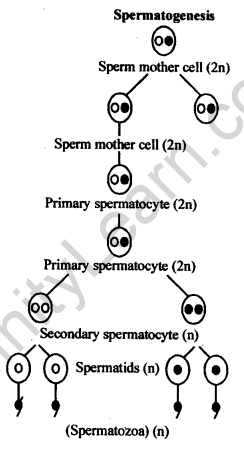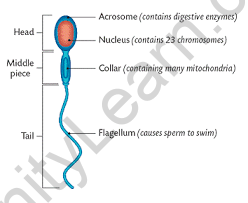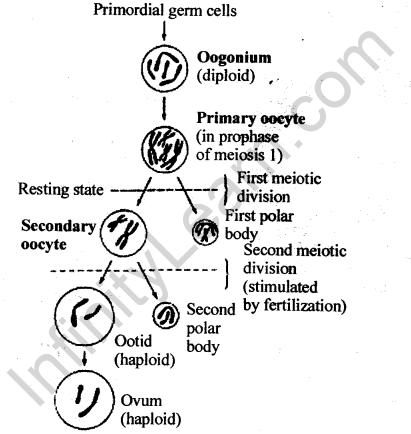Table of Contents
Human reproduction is an important topic in Class 12 Biology that helps students understand how new life is created and how our bodies work to continue the human species. These human reproduction class 12 notes are designed to simplify the topic and make it easier for students to learn and remember.
In these class 12 human reproduction notes, you will find detailed explanations of the reproductive system, processes like fertilization, pregnancy, and childbirth. The human reproduction class 12 biology notes are prepared in simple language to help you grasp the concepts clearly.
If you are looking for easy access, you can download the human reproduction class 12 notes pdf which contains all the important points and diagrams for quick revision. These human reproduction notes class 12 are also useful for solving questions and preparing for exams.
For additional help, there are NCERT solutions for class 12 human reproduction available which provide step-by-step answers to textbook questions. To test your knowledge, you can also practice human reproduction class 12 MCQs which cover important topics and help you get ready for exams.
Human Reproduction Class 12 Notes PDF
The Infinity Learn website offers Human Reproduction class 12 notes PDF for students to download easily. This PDF is designed according to the latest CBSE syllabus, so class 12 students get the most updated information about the chapter Human Reproduction.
Students can download the human reproduction class 12 notes PDF anytime from the comfort of their home using the Infinity Learn website. These class 12 human reproduction notes help clear all doubts and make it easier to understand important concepts. Using these notes, students can also improve their thinking skills, which will help them answer questions related to Human Reproduction confidently.
Human Reproduction Class 12 Notes Questions with Answers
1. Fill in the blanks:
(a)Humans reproduce————— (asexually/sexually).
(b)Humans are————— (oviparous, viviparous,ovoviviparous).
(c)Fertilization is————— in humans (external/internal).
(d)Male and female gametes are—————(diploid/haploid).
(e)Zygote is————— (diploid/haploid).
(f)The process of release of ovum from a mature follicle is called————— .
(g)Ovulation is induced by a hormone called—————
(h)The fusion of male and female gametes is called————— .
(i)Fertilization takes place in—————
(j)Zygote divides to form————— which is implanted in uterus.
(k)The structure which provides vascular connection between foetus and uterus is called————— .
Ans:(a) sexually
(b) viviparous
(c) internal
(d)haploid
(e)diploid
(f)ovulation
(g)LH (Luteinizing hormone)
(h)fertilization
(i)ampullary-isthmic junction (fallopian tube)
(j)blastocyst
(k)placenta (Umbilical cord)
2. Draw a labelled diagram of male reproductive system.
Ans:

3. Draw a labelled diagram of female reproductive system.
Ans:
4. Write two major functions each of testis and ovary.
Ans:Testes are components of both the reproductive system (being gonads) and the endocrine system (being endocrine glands). The respective functions of the testes are – producing sperm (spermatozoa) by the process of spermatogenesis and producing male sex hormones, of which testosterone is the best-known. Testosterone stimulates development of testes and of male secondary sexual characteristics.
The ovaries have two major functions. One is the production of eggs or ova, and the second is the production of hormones or chemicals which regulate menstruation and other aspects of health and well-being, including sexual well-being. Estrogen and progesterone are the most important hormones which serve many functions like, they induce and maintain the physical changes during puberty and the secondary sex characteristics and they support maturation of the uterine endometrium in preparation for implantation for a fertilised egg, etc.
5. Describe the structure of a seminiferous tubule.
Ans: The seminiferous tubule is a structural unit in the adult testis. The seminiferous tubules are situated in testicular lobules. Seminiferous tubule consists of two types of cells – Sertoli or supporting cells & spermatogenic cellsl Sertoli cells, are elongated and pyramidal & partially envelop the spermatogenic cells. The cells provide nourishment to the developing spermatogenic cells. Spermatogenic cells are stacked in 4-8 layers. These cells divide several times & differentiate to produce spermatozoa. Between seminiferous tubules lie the interstitial cells or leydig cells which produces testosterone hormone.
6. What is spermatogenesis? Briefly describe the process of spermatogenesis.
Ans: Spermatogenesis is the process of producing sperms with half the number of chromosomes (haploid) as somatic cells. It occurs in seminiferous tubules. Sperm production begins at puberty continues throughout life with several hundred million sperms be ing produced each day. Once sperm are formed they move into the epididymis, where they mature and are stored. During spermatogenesis one spermatogonium produces 4 sperms. Spermatogenesis completes through the following phases – multiplicative phase, growth phase, maturation phase & spermiogenesis. In multiplicative phase the sperm mother cells divide by mitosis & produce spermatogonia. The spermatogonia grow in size to form large primary spermatocytes by getting nourishment from sertoli cells in growth phase. Maturation phase involves meiosis I in which primary spermatocytes divide to produce secondary spermatocyte and meiosis II which produces spermatids. Thus each primary spermatocyte gives rise to four haploid spermatids. Spermiogenesis or spermateliosis is process of formation of flagellated spermatozoa from spermatids. Spermiogenesis begins in the seminiferous tubules but usually completed in epididymis.

7. Name the hormones involved in regulation of spermatogenesis.
Ans: The hormones involved in regulation of spermatogenesis are GnRH, LH, FSH and androgens.
Spermatogenesis starts at the age of puberty due to significant increase in the secretion of gonadotropin releasing hormone (GnRH). The increased levels of GnRH then acts at the anterior pituitary gland and stimulates secretion of two gonadotropins – luteinising hormone (LH) and follicle stimulating hormone (FSH). LH acts at the Leydig cells and stimulates synthesis and secretion of androgens. Androgens, in turn, stimulate the process of spermatogenesis. FSH acts on the Sertoli cells and stimulates secretion of some factors which help in the process of spermiogenesis.
8. Define spermiogenesis and spermiation.
Ans: Spermiogenesis is the process of transformation of spermatids into mature flagellated spermatozoa (sperms).Spermiation is the process of release of mature spermatozoa. In this spermatozoa are shed into the lumen of seminiferous tubule for transport.
9. Draw a labelled diagram of sperm.
Ans:

10.What are the major components of seminal plasma?
Ans: Seminal plasma is the fluid in which sperm is ejaculated. Major components of seminal plasma are secretions from seminal vesicles, prostrate and bulbourethral gland and sperms from testis. It is rich in fructose and contains enzymes, citric acid, hormones like prostaglandins, calcium and clotting proteins.
11. What are the major functions of male accessory ducts and glands?
Ans: Male accessory ducts include rete testis, vasa efferentia, epididymis and vas deferens. These ducts store and transport sperms from the testis to the outside through urethra. The male accessory glands include paired seminal vesicles, a prostate and paired bulbourethral glands. Secretions of these glands constitute the seminal plasma which is rich in fructose, calcium and certain enzymes. The secretions of bulbourethral glands also helps in the lubrication of the penis.
12. What is oogenesis? Give a brief account of oogenesis.
Ans: The process of formation of a mature female gamete (ovum) is called oogenesis. It occurs in the ovaries of female reproductive system. Oogenesis is a discontinuous process it begins before birth, stops in midprocess & only resumes after menarch. It occurs in three phases : Multiplicative phase (formation of oogonia mitotically from the primary germ cells), Growth phase (growth of oogonia into primary oocyte) & Maturation phase (formation of mature ova from primary oocyte through meiosis). Maturation phase produces two haploid cells – Larger one called secondary oocyte & the smaller one called polar bodies (1st polar body). Meiosis II of secondary oocyte results in the formation of functional egg or ovum and a second polar body: The first polar body may also divide to form two polar bodies of equal sizes which do not take part in reproduction & ultimately degenerates. First maturation division may be completed in the ovaries just prior to ovulation but second one (Final) is completed outside the ovary after fertilization. Secondary oocyte is female gamete in which the 1st meiotic division is completed & second meiotic division (Metaphase stage) has begin. The egg is released at secondary oocyte stage under the effect of LH.

13. Draw a labelled diagram of a section through ovary.
Ans:
14. Draw a labelled diagram of a Graafian follicle.
Ans:
15. Name the functions of the following:
(a) Corpus luteum
(b) Endometrium
(c) Acrosome
(d) Sperm tail
(e) Fimbriae
Ans: (a) Corpus luteum : The corpus luteum secretes large amounts of progesterone which is essential for maintenance of the endometriuip.
(b) Endometrium is necessary for implantation of the fertilized ovum and other events of pregnancy.
(c) The acrosome is filled with enzymes that help during fertilization of the ovum.
(d) Sperm tail: Tail facilitates sperm motility which is essential for fertilization.
(e) Fimbriae: Fimbriae help in collection of the ovum after ovulation.
16. Identify True/False statements. Correct each
false statement to make it true.
(a) Androgens are produced by Sertoli cells. (True/False)
(b) Spermatozoa get nutrition from sertoli cells. (True/False)
(c) Leydig cells are found in ovary. (True/ False)
(d) Leydig cells synthesize androgens. (True/ False)
(e) Oogenesis takes place in corpus luteum. (True/False)
(i) Menstrual cycle ceases during pregnancy. (True/False)
(g) Presence or absence of hymen is not a reliable indicator of virginity or sexual – experience. (True/False)
Ans: (a) False, Androgens or male sex hormones (e.g, testosterone) are secreted by Leydig cells.
(b) True.
(c) False, Leydig cells are found in testis.
(d) True.
(e) False, Oogenesis takes place in ovary.
(f) True.
(g) True.
17. What is menstrual cycle? Which hormones regulate menstrual cycle?
Ans: Menstrual cycle is the cyclic change( itf’the reproductive tract of primate female. This period is marked by a characteristic event repeated almost every month (28 days with minor variation) in the form of a menstrual flow (i.e. shedding of the endometrium of the uterus with bleeding. It may be temporarily stopped only in pregnancy.
The hormones that regulates menstrual cycles are
(i) FSH (Follicle stimulating hormone),
(ii) LH (Luteinizing hormone),
(iii) Oestrogens,
(iv) Progesterone.
18. What is parturition ? Which hormones are involved in induction of parturition?
Solution:
Parturition (or labour) means child birth. Parturition is the sequence of actions by which a baby and the afterbirth (placenta) are expelled from the uterus at childbirth. The process usually starts spontaneously about 280 days after conception, but it may be started by artificial means.
The process of parturition is induced by a complex neuroendocrine mechanisms involving cortisol, estrogen and oxytocin.
19. In our society the women are often blamed for giving birth to daughters. Can you explain why this is not correct?
Ans: The sex chromosome pattern in the human females is XX and that of male is XY. Therefore, all the haploid female gametes (ova) have the sex chromosome X, however, the haploid male gametes have either X or Y. Thus 50% of sperms carry the X-chromosome while the other 50% carry the Y-chromosome. After fusion of the male and female gametes, the zygote carries either XX or XY depending upon whether the sperm carrying X or Y fertilizes the ovum. The zygote carrying XX would be a female baby and XY would be a male baby. That is why it is correct to say that the sex of the baby is determined by the father.
20. How many eggs are released by a human ovary in a month? How many eggs do you think would have been released if the mother gave birth to identical twins? Would your answer change if the twins born were fraternal?
Ans: One egg is released by human ovary in a month. Identical twins: Identical twins are formed when a single fertilized egg splits into two genetically identical parts. The twins share the same DNA set, thus they may share many similar attributes. However, since physical appearance is influenced by environmental factors and not just genetics, identical twins can actually look very different.
Fraternal twins: These twins are formed when two fertilized eggs are formed. The twins share the different DNA set, thus they may share different attributes (dizygotic embryo).
21. How many eggs do you think were released by the ovary of a female dog which gave birth to 6 puppies?
Ans: Since dogs have multiple births, several eggs mature and are released at the same time. If fertilised, the egg will implant on the uterine wall. Dogs bear their litters roughly 9 weeks after fertilisation, although the length of gestation can vary from 56 to 72 days. An average litter consists of about six puppies, though this number may vary widely based on the breed of dog. On this basis 6 eggs were released by the ovary of a female dog which gave birth to 6 puppies.
Features of Human Reproduction Class 12 Notes
The human reproduction class 12 biology notes are an important study resource because they have several useful features:
- Clear Explanations: Every topic is explained in detail, so students can understand easy to difficult concepts easily.
- PDF Format: The notes are available in PDF form, which makes it simple for students to access and study anytime.
- Colorful Diagrams: The notes include attractive and clear diagrams that help students understand the reproductive system better.
- Complete Coverage: All topics from the chapter are covered so students don’t miss any important point.
- Latest Syllabus: The notes are prepared according to the newest syllabus guidelines, helping students stay updated.
- Simple Language: The content is written in easy and simple language so everyone can understand the topics without difficulty.
- Well-Organized Format: The notes are arranged neatly and attractively, making studying more enjoyable.
Advantages of Human Reproduction Notes Class 12
Using the Human Reproduction notes class 12 offers many benefits:
- Important Study Tool: These notes provide all the important information in one place, making studying easier.
- Better Understanding: The notes explain topics clearly, which helps improve comprehension and creativity for exams like board exams and NEET.
- Easy to Remember: Students can memorize key points and concepts quickly with the help of these notes.
- Focused Preparation: The notes help students stay focused while studying the chapter.
- Organized Record: They keep all the information from brief points to detailed explanations in a systematic way.
- Quick Revision: The notes are perfect for fast revision before exams, helping students recall facts, definitions, and diagrams easily.
- Useful for All Boards: Whether students are in CBSE or any state board, these notes help them perform well in board exams.
How Are Human Reproduction Class 12 Notes Prepared?
The class 12 human reproduction notes are carefully made following the latest CBSE Class 12 Biology syllabus so that students get the most current and accurate knowledge. Covering all important topics and concepts helps students score well in both board exams and competitive exams like NEET Exam.
Tips for Class 12 Students Using Human Reproduction Notes
Students can follow some simple tips to study the chapter effectively:
- Read All Topics: First, go through all the topics to get an overview of the chapter.
- Cover All Concepts: Use the notes to study all the concepts in detail.
- Practice Questions: After learning the topics, try practicing questions from the chapter.
- Stay Focused: While preparing, avoid distractions and focus only on Human Reproduction.
- Correct Mistakes: Use the notes to clear doubts and fix mistakes as you study, which helps improve understanding.
How Human Reproduction Class 12 Notes Improve Your Preparation
These notes help students cover all topics as per the syllabus, including easy, moderate, and difficult ones. This complete coverage helps students answer questions confidently and score better marks in exams.
What Are Human Reproduction Notes Class 12 and Why Are They Important?
Human Reproduction notes class 12 are a summary of the entire chapter. They explain all topics and concepts in a simple and precise way, helping students build a strong foundation and perform well in exams.
Human Reproduction Class 12 Notes FAQs
Where can I download Human Reproduction Class 12 notes PDF?
You can download the Human Reproduction Class 12 notes PDF from the Infinity Learn website or other trusted educational portals that provide syllabus-based study materials.
Are these Human Reproduction notes for Class 12 available according to the latest syllabus?
Yes, the notes are prepared as per the latest CBSE and state board syllabus to help students study updated content efficiently.
Do the Human Reproduction Class 12 notes include diagrams?
Yes, the notes contain clear and colorful diagrams to help students better understand the concepts of the human reproductive system.
Can I find NCERT solutions for Class 12 Human Reproduction chapter?
Yes, NCERT solutions are available to help students solve textbook questions step-by-step and clear their doubts easily.
Are there any practice questions or MCQs included in the Human Reproduction Class 12 notes?
Yes, many notes and study materials include multiple-choice questions (MCQs) to help students practice and prepare for exams like CBSE boards and NEET.








